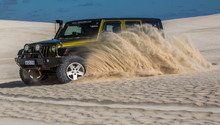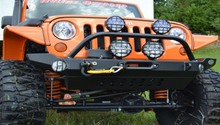Jeep Wrangler JK: How to Connect Tow Straps
Effective towing and recovery comes down to the equipment being used. Towing and recovery puts high stress onto the vehicle. Not using factory approved tow points, such as an axle, can cause significant damage. Knowing your options in these situations will help you make safe, effective decisions for a successful tow/recovery.
This article applies to the Jeep Wrangler JK (2007-Present).
Towing and recovery can be a dangerous procedure if performed without the proper knowledge. Many people have been hurt or injured by using equipment improperly. Factors like gross vehicle weight, equipment tensile strength, and surrounding obstacles can make a successful recovery much more difficult. Your Jeep JK may not include front and rear towing points from the factory. This complicates the towing and recovery process, but you do have options. Read through this article to discover your alternatives and the equipment you'll need to make them work.

Materials Needed
- Recovery strap (20'-40'+)
- Towing strap (towing only)
- Tree strap (anchoring to tree)
- D-rings (to connect to factory tow points)
This is an excerpt regarding the use of tow straps from the 2009 Jeep Wrangler owner's manual:
Your JK may or may not be equipped with tow hooks. If so, they can be mounted in the front and rear. For off-road recovery, it's recommended to use both front hooks to minimize the risk of damage. Chains are not recommended for freeing a stuck vehicle. Chains may break, causing serious injury or death. Stand clear of vehicles when pulling with tow hooks. Tow straps and chains may break, causing serious injury. Do not use chains! Do not use metal tow hooks!
Step 1 – Analyze the situation
What tow/recovery equipment you choose to use will depend on the situation. Whether you are recovering a stuck vehicle, recovering yourself using an anchor point, or towing another vehicle, the proper technique to complete the job safely will be different.
To start, you need the correct recovery/towing equipment. Tow straps differ from recovery straps. Tow straps are designed not to stretch to increase safety as the towed vehicle is traveling behind you. Recovery straps use elasticity to stretch than shrink. This force helps propel the vehicle from its stuck, stationary position. Tree straps are used to safely anchor to a tree. These straps distribute the force evenly around the tree to lessen the chance of damage to the tree and strap.
Chains and metal hooks are not recommended for towing/recovery use. When metal objects break under tension, the sudden release may allow the chain or hooks to act as a slingshot, causing serious injury or death.
The smartest ways to tow/recover another vehicle are by using factory tow hooks or tow points. Another way is using a recovery hitch mounted to the rear of the vehicle. Another method (although not very safe) is using a short length of chain with a set of hooks. These hooks can be attached to the frame. Make sure your equipment is rated above the capacities of the vehicle being towed.
If you need to increase the length of your strap during a recovery, you can slide one strap through the eye loop of the strap connected to the tow vehicle. Attach the two eye loops from the other strap to the vehicle being towed.

Figure 1. A recovery strap. 
Figure 2. A recovery hitch. 
Figure 3. Attaching D-rings to front tow points for easy strap connection.
Step 2 – Successfully connect tow/recovery straps to vehicle
This list was written by JK-Forum.com member hesh. It serves as a good guide to use while performing a recovery:
- Never use a tow strap for recovery.
- Never use a strap with metal hooks on the end.
- Never use a strap with chain ends.
- Never use a damaged strap.
- Never use a chain.
- Never use a strap, hitch, or D-ring not rated for the given loads/stresses.
- Never place a D-ring in the middle of the two straps.
- When closing in a D-ring, once threaded all the way in, back it out a quarter turn for easy de-latching when complete.
If you are faced with the decision to hook to the frame with metal hooks, cover the chain section with a heavy blanket or similarly weighted object. This will damped the snapping force that will occur if the hooks separate from the frame.
Make sure your straps are in good condition before use. Inspect the straps for tears. Some straps contain red nylon bands. If you see these red bands, the strap needs to be replaced.
Slowly put tension on the strap. If your towing, the strap should NOT stretch. Keep in mind that once the slack is removed from the strap, all the vehicle's weight plus the force required to move the vehicle from its position will be placed on the strap. Recovery straps will stretch until its maximum stretch limit is reached. The strap will then spring back, creating a pull against the stuck vehicle.
Related Discussions
- How to Use Tow Recovery Strap - JK-Forum.com
- Safe Way to connect Tow Strap to Vehicle - JK-Forum.com
- Connecting Tow Straps Safely - JK-Forum.com






